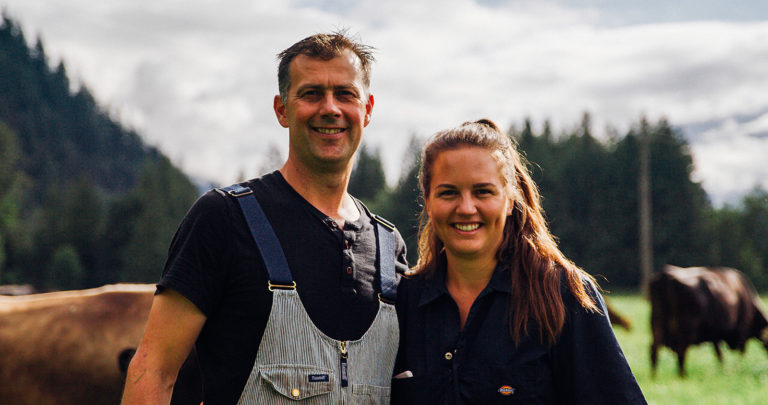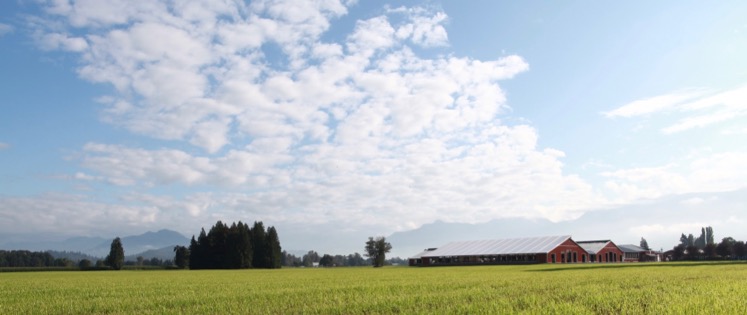All cows have split hooves, four stomachs, and a total of 32 teeth, but in many ways they are very different. Each breed lives differently, eats differently, and produces differently. We must remember–its not all black and white.
It should be noted that there are some basic tenets that make all cows the same; all cows have split hooves, four stomachs, and have a total of 32 teeth. But size, structure, and milk composition, are distinguishing factors for these animals. Not all dairy cows are the same.
Holstein
The Holsteins are the black and white cow that dominate the dairy industry—more than 93% of the national herd is comprised of Holsteins. While this cow was once used for both milk and meat, it is now predominantly a dairy producer. The first Holsteins were introduced into Canada in the 1800s from the Netherlands and were admired for the amount of milk they produce and adaptability. The Holsteins have an average of 3.9% butterfat and a 3.2% protein in their milk.
As the Canadian population steadily increases, these high producers continue to meet the demands of hungry Canadians, naturally.
Guernsey
The Guernseys originated from the channel island of Guernsey and came to Canada by accident. A shipment of Guernseys set sail for New England, but rough seas forced the herd to make Nova Scotia their home. Brown and white in colour, one of the striking characteristics of Guernseys is their quiet temperament.
Guernsey milk is very unique; these cows produce milk that has a high ratio of butterfat to protein: 4.81% butterfat and 3.5% protein. Their milk is naturally golden hued.
Brown Swiss
These cows originated in Switzerland and are thought to be one of the oldest breeds in the world. Their brown colouring ranges from dark to light brown, and sometimes grey. The Brown Swiss officially made their way to Canada in 1888. These cows perform well in all climates and altitudes—their eyes are dark blue and have a distinguished ability to block out radiation from the sun.
The milk of the Brown Swiss has 4.16% butterfat content and 3.5% protein content. Due to the fat-to-protein ratio, the milk of the Brown Swiss is ideal for making cheeses.
Jersey
The first of these petite fawn coloured cows came into Canada in 1868 in Quebec as an import from the channel island of Jersey. Due to their small size and quick metabolic rate, Jerseys have reportedly lower feed costs compared to larger breeds. These hardy cows have a high heat tolerance and are highly adaptable to their environment.
Though Jerseys produce less milk than Holsteins or Brown Swiss, they have a notably higher butterfat of 4.9% and protein of 3.9% in their milk—this milk is also perfect for making cheese. The majority of Jersey herds today are in Ontario and Quebec, with several in British Columbia and comprise of 4% of the national herd.
Ayrshire
The Ayrshire is a red and white cow originating from Scotland. This cow is tall and bold; tempered by rocky landscapes and unforgiving climates, this breed is vigorous and able to withstand our frigid Canadian temperatures. The Ayrshires arrived in Canada in the early 1800s and grew to become 3% of the national herd.
The Ayrshire has an average butterfat of 4.13% and 3.3% of milk proteins. It should be noted that this animal is tough; there are few other breeds that can match the hardiness of the Ayrshire.
Milking Shorthorn
The milking shorthorn was a breed established in the 1700s in England and imported into Canada in 1832. The coat of a shorthorn is a mixture of red and white. As mid-range producers, these cows produce a volume of milk in between the Holstein and the Jersey. Shorthorn milk has a butterfat content of 4.0% and protein content of 3.5%.
Contrary to their name, the shorthorn are naturally polled animals—they are born without horns and are incredibly docile creatures.
Canadienne
A breed unique to Canada, these cows were brought by French settlers in 17th century. After adapting to cool Canadian climates, these short, black/brown cows have made the Quebecois farmlands their home. As a primary producer for Canada in the settling years, the Canadienne would produce a milk of high quality for the brisk temperatures. The Canadienne produces the same volume as the Jersey, but with 4.4% butterfat and 3.6% milk protein.
Due to its unique Canadian heritage and the decreasing number of animals, the Canadienne is now a protected heritage breed and crossbreeding is no longer allowed.
All cows have split hooves, four stomachs, and a total of 32 teeth, but in many ways they are very different. Each breed lives differently, eats differently, and produces differently. While the Canadian dairy industry has its main players in production, we must remember—it’s not all black and white.
References
- Ayrshire Breeders Association of Canada. Web. http://www.ayrshire-canada.com/en/historique.php.
- “Breeds of Livestock—Ayrshire Cattle” Oklahoma State University. Web. 1995. http://www.ansi.okstate.edu/breeds/cattle/ayrshire/
- “The Canadienne Cow” Association de Mise en Valeur Des Bovins de Race Canadienne Dans Charlevoix. Web. http://www.vachecanadienne.com/en.aspx
- Jersey Canada. “Jersey History”. 2018. https://www.jerseycanada.com/pages/jersey-history.html
- Canadian Milking Shorthorn Society. “Milking Shorthorns –an Efficient Dairy Alternative” 2018. http://www.cmss.on.ca/breed.html
- Elischer, Melissa. “History of dairy cow breeds: Milking Shorthorn” Michigan State University. April 17, 2017. http://msue.anr.msu.edu/news/history_of_dairy_cow_breeds_milking_shorthorn
- “Canada’s Animal Genetic Resources: Cattle Breeds in Canada” March Agriculture and Agri-Food Canada. March 1997. http://publications.gc.ca/collections/collection_2015/aac-aafc/A54-8-1998-2-eng.pdf
- “The Holstein Breed” Holstein Canada. Web. Date accessed: April 15, 2018. https://www.holstein.ca/Public/en/About_Us/The_Canadian_Dairy_Industry/The_Holstein_Breed



